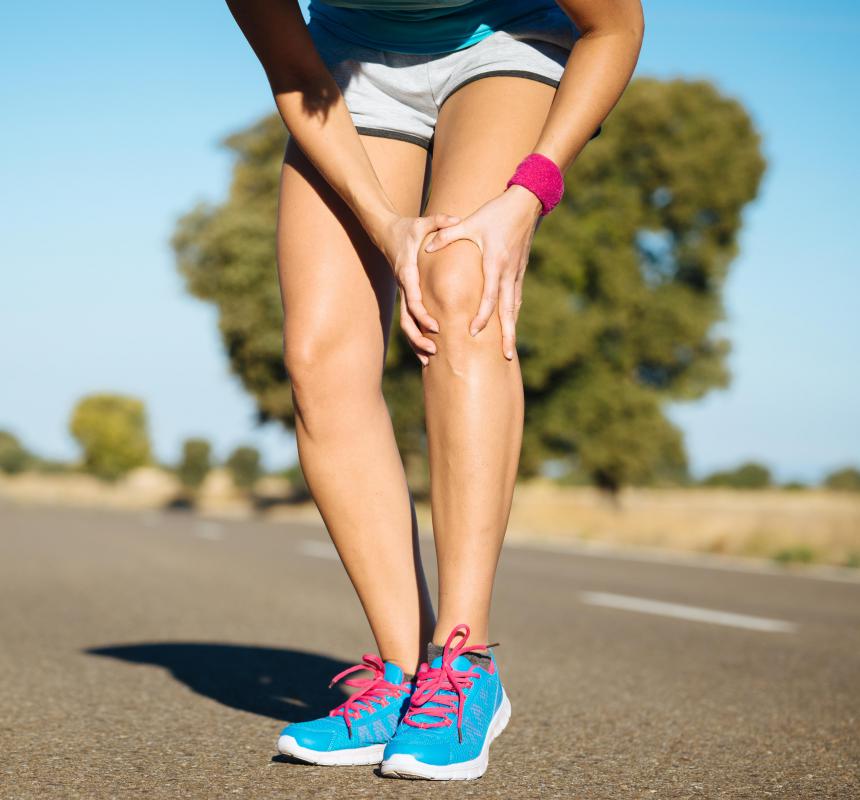At WiseGEEK, we're committed to delivering accurate, trustworthy information. Our expert-authored content is rigorously fact-checked and sourced from credible authorities. Discover how we uphold the highest standards in providing you with reliable knowledge.
What is a J Brace?
Many different types of braces are designed to provide support to the knee area; the J brace is a type designed to support the patella, or kneecap, in a semi-rigid fashion. This knee brace is made of fabric or related flexible material, and it has a strap mechanism that is wound around the knee joint area in a “J” fashion. These straps provide additional flexibility by being able to be loosened or tightened at the inner side of the knee. The brace also commonly has two steel “stays,” or insets, in the fabric along the sides of the brace that provide support, but limit knee movement during activity.
The J brace is a type of leg brace that is also known as a patella brace, since it focuses primarily on helping to reduce pain and limited function in the knee area. This pain and function disability can be due to a wide range of ailments that affect persons of widely varying age groups, from chondromalacia of the patella in youths, to a dislocated patellas in sports enthusiasts, to knee conditions caused by arthritis in the middle-aged or elderly. The J brace also has been recommended by medical practitioners as a device which can help reduce postoperative pain, as well as help to regain knee motion and flexibility.

The main function of the J brace is to help the patella remain in proper anatomic position during movements of the knee. This helps stabilize the knee and make it less prone to dislocating, or moving out of position. Since the J brace is a patella-stabilizer brace, it helps to reduce pain, discomfort, and inflammation in the knee area. One way it helps to do this is to prevent the patella from shifting away from the groove in the middle of the knee when bending and straightening the knee — called patella tracking disorder — which can happen when the connective tissue on back of the kneecap is worn away due to aging or overuse.

A form of knee brace called the hinged J brace has hinges at the back of the knee to enable easier bending. The supports along the sides of the knee are also bendable. This brace also generally contains a knee “buffer” or pad surrounding the bottom of the kneecap to cushion the knee during contact. Many are shaped in an “hourglass” pattern, with Velcro® fasteners that open at the top of the hourglass along the front of the lower thigh area just above the knee joint.

According to the Mayo Clinic, knee braces fall into two basic types. They are either off-the-shelf braces that have been pre-made in a standard range of sizes, or they are custom braces that are made to fit a person’s individual anatomy. Custom braces are prescribed by a medical professional and are made by an orthotist, a specialist who designs and makes medical devices such as braces. Both types of braces can help to lessen knee pain and dysfunction, but it is recommended to use this type of brace as an aid, instead of a replacement, for medical therapy.

If a person wishes to obtain a ready-made knee brace, such as from the Internet, he or she should consider some of the factors that a doctor or sports medicine professional would consider may be helpful: how a brace may improve certain types of activity, for instance, with bending, walking, or climbing, and then deciding which type of brace might provide the best fit. How difficult it would be to adjust is another consideration. Additionally, it is important to become informed about how long to wear the brace at any one time, since wearing it too constantly could lead to muscle weakening, and cause yet further problems in the area being braced.
AS FEATURED ON:
AS FEATURED ON:


















Discuss this Article
Post your comments